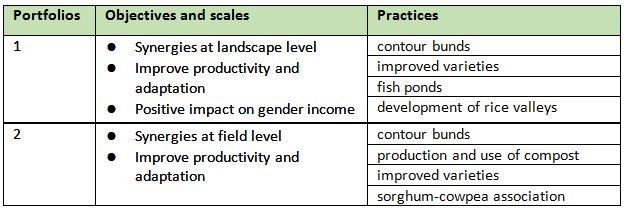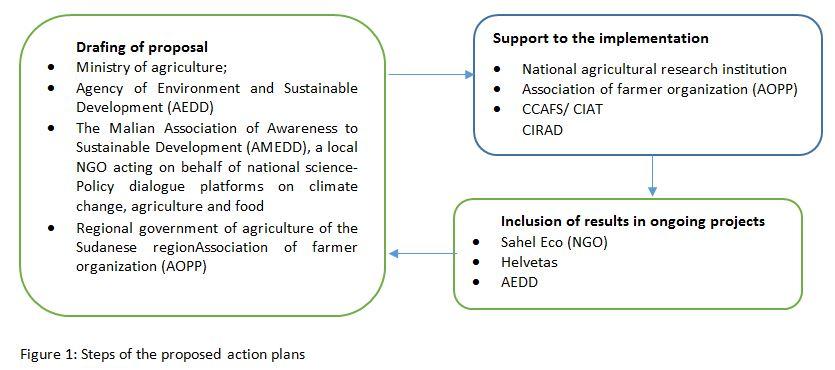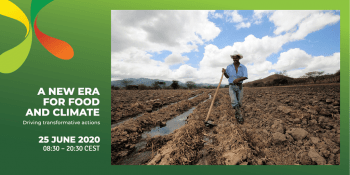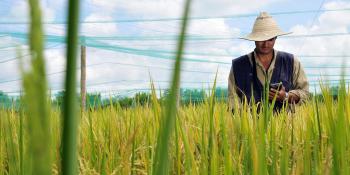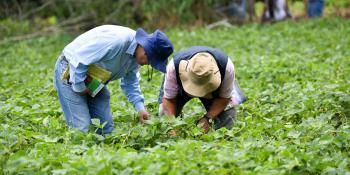Prioritizing climate-smart investment in Mali

Decision-makers in Mali are working to integrate climate change into agriculture planning and to prioritize investments.
Malian agriculture stakeholders, decision-makers, and donors have been working for the past year to identify climate-smart agriculture (CSA) solutions for the country. At the end of 2015, 30 national and international stakeholders came together in Bamako to prioritize climate-smart investments in Mali.
This event was the conclusion of a year-long project using the Climate-Smart Agriculture Investment Prioritization Framework developed by the International Center Tropical Agriculture (CIAT) and the CGIAR Research Program on Climate Change, Agriculture, and Food Security (CCAFS), and led in Mali by AEDD and the NGO AMEDD on behalf of the CCASA platform. Starting in September 2014, Malian stakeholders (representants of national universities, of agricultural research centers, donors, ministry of agriculture, farmer associations, NGOs etc.) have been conducting participatory decision-making processes to identify CSA practices that increase productivity, resilience, and mitigation, while also being profitable to farmers and society. The processes helped to define:
- Vulnerable and strategic regions (the Sudanese, Sudano-Sahelian, and Sahelian regions) and production systems of interest for food security.
- A long list of CSA practices relevant to the regions and their performances regarding the 3 pillars of CSA (productivity, adaptation and mitigation).
- A short list of 10 best-bet CSA practices, taking into account stakeholder criteria for prioritization costs and benefits of the CSA practices selected for the Sudanese region used to build CSA investment portfolios for the region.
This was the first time participants were viewing the results from the Community Based Adaptation (CBA) assessments of the 10 best-best practices for the Sudanese region. The methodology and results were validated, which included the innovative inclusion of externalities such as gender, conflicts of access to land, and carbon sequestration. During this final closure workshop, the participants had the crucial task of linking the results of all phases of the Prioritization Framework and make a final prioritization of CSA portfolios of 3 to 5 CSA practices for the Sudanese region.
Portfolios were developed in subgroups of experts. Participants used the results of the assessment of impact on CSA pillars, the CBA analyses, and their own expertise to determine the objective, scale, and content of their desired portfolios. Did they want to put together practices with the best synergies at the field, farm, or landscape level? Did they want the practices to have a major impact on a specific CSA pillar or that were financially profitable? Participants used visualization mechanisms to compare the tradeoffs between practices and between different portfolios of practices to aid them in selecting final portfolios. Each group developed a number of portfolios, and the workshop as a whole selected two priority portfolios for further investigation and investment.
The selected practices are already being implemented by some farmers but are not widely adopted due to lack of incentives (due to the lack of coordination of the actors of the value chains, of infrastructure, of capacity building of farmers). To facilitate and foster the use of these portfolios in ongoing or future projects, the participants consequently worked on key elements for an action plan to boost the enabling environment for scaling out these practices, which could be further developed with interested institutions. Actions included:
Capacity building of farmers
- on the ongoing and future challenges posed by climate change
- on the potential impact of the practices
Research programs
- on the difficulties currently encountered by farmers to adopt the prioritized practices
- on ways of improving practices for specific agroecosystems
Strengthening of the institutional environment
- regional platforms to link actors to value chains
- coordinated policies across levels, especially bringing farmer preferences into decision-making
Implementation of practices prioritized for investment
- development of on-farm infrastructure needed for practice adoption
This event raised the interest of participants to continue being involved in outscaling the process to other regions and supporting uptake of prioritized practices in the Sudanese region (Figure 1).
High level decision-makers from the Malian government, NGOs, and donors gathered in a separate briefing to learn the results of the workshop. These stakeholders confirmed their support for the large scale implementation of CSA portfolios in Mali, applauded the assessment of multiple CSA related impacts and costs and benefit studies that included externalities. Results were highlighted as useful for design of future call for proposals, as responses to ongoing calls, methodologies for use in assessing existing projects, and presentation of results at regional and global meetings.
The impressively strong involvement of all the stakeholders throughout the entire process helped to raise new questions, debate, and insights related to ongoing and future CSA actions, including:
- Affirmation that the integration of the 3 CSA pillars matches the orientation of many Malian and international institutions working in the agriculture sector.
- A need exists to link this process, driven by actors at the national level, with actors at local levels to understand how the criteria used to prioritize CSA initiatives match with farmer priorities (e.g. the selected externalities).
- CBA analyses of practices are useful not only for farmers but also for donors and governments looking for sustainable projects.
- Integration of the externalities into the CBA can be an important mechanism for changes, perceptions of profitability and associated behaviours at different levels, from donors to farmers.
Next steps for the Prioritization Framework implementing team, led by AMEDD, include close follow up with the interested institutions to find opportunities for use of this process in future projects/programs/calls for proposal. The team is also constructing a CSA Country Profile for Mali, with USAID support, to be released later in 2016 which will further assess opportunities for CSA, including review of ongoing and promising practices related to key production systems across the country, an overview of institutions and policies linked to CSA, and finance opportunities.
Read more
Fanny Howland is Research Associate at the International Center for Tropical Agriculture (CIAT).

